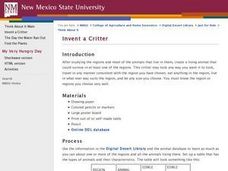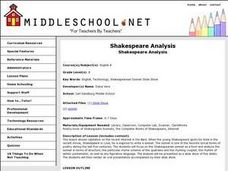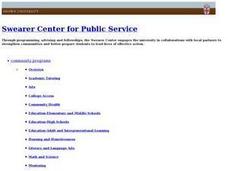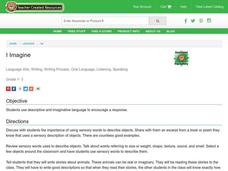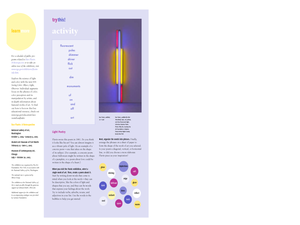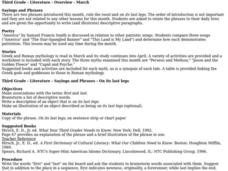Curated OER
"The Pianist" As A Tool For Classroom Instruction About the Holocaust
Students watch "The Pianist" to gain insight on the Holocaust and World War II. They write an essay based on ideas from the film and read a variety of poems and writings from the time period. In groups, they discuss the diffuculties of...
Curated OER
Chocolate Chaos
Second graders demonstrate the ability to examine the elements of a story (theme, plot, setting, mood) and characters, by discussing and writing about each. They have fun with chocolate related activities and enjoy reading about some...
Curated OER
About Life: The Photographs of Dorthea Lange - Images of Children in Dorothea Lange's Photographs
Young scholars examine how visual artists tell stories with their work. In this visual art instructional activity, students study two of Dorothea Lange's photographs to find elements of art and narrative content, use descriptive language...
Curated OER
A Round and A Round
Learners practice singing rounds in daily warm-ups for 2 weeks prior to beginning this composition lesson. Students incorporate movement to the rhythm of each syllable, discuss syllables of words and their relationship to note values and...
Curated OER
Invent a Critter
Students create a living animal that could survive in at least one specific region and use the digital desert library to gather information. In this invent a critter lesson, students draw a picture of their animal, describe their...
Curated OER
Create a Computer Story
Second graders will create their own story and read it aloud. In this literacy/technology lesson, 2nd graders use computer software to create their own story, which is read back to them while they write it. Afterward, the student should...
Curated OER
Mosaic Pavement Panel
Young scholars analyze Mosaic art and identify the tessellation process. In this Mosaic art lesson, students read information about Mosaic art and the tessellation process. Young scholars compare mosaics from various civilizations and...
Curated OER
Shakespeare Analysis
Eighth graders focus on the Shakespearian sonnet as a form and analyze the sonnet in terms of structure, the particular rhyme scheme of the quatrains and the rhyming couplet, the rhythm of iambic pentameter, as well as any figurative...
Curated OER
You Too Can Haiku
Students conduct Internet research and explain the history of Haiku. After listening and reading various examples of Haiku, students use their own vocabulary and practice their math skills to determine the correct number of syllables...
Curated OER
Haiku
Fourth graders create a haiku. They use a digial camera and file management techniques to save work. They also use a photo editor to manipulate the pictures. Finally, they create a PowerPoint presentation of their Haiku.
Curated OER
Rock N Rhythm & Rhyme
Students explore rhyming and rhythm. In this rhythm and rhyme lesson, students listen to the song, "A-Hunting We Will Go" and add new verses to the song with words that rhyme. Students use an interactive tool to create these new verses.
Curated OER
See Me, Feel Me, Hear Me, Describe Me!
Fifth graders read the poem "Root Cellar" and then close their eyes and describe objects that are placed in their hands.
Curated OER
Celebrating Saturn and Cassini
Students use their notes from previous lessons to write a paper on Saturn or Cassini. They share their writings with the class. They discover how everyone has a different learning style.
Curated OER
Fall Similes
Students create descriptive autumn similes and write them on fall-themed paper. They first write the autumn simile, and then arrange the plants around the border of the paper. They use natural plants which must be pressed.
Curated OER
I Imagine
Students discuss the importance of using sensory words to describe objects; talking about words that refer to size, shape, texture, sound, smell, etc. They select a few objects around the classroom and use sensory words to describe.
Curated OER
Nouns Practice
In this noun activity, students read a poem and box in all nouns, write nouns that fit given descriptions, and circle nouns in sentences.
Curated OER
Electric Light Art
Students write a poem about a single work of art by Flavin. In this descriptive response activity, students express their feelings about the work and organize words into phrases. Students arrange word phrases on paper to form...
Curated OER
Literature
Third graders study phrases, poetry and myths of Ancient Greece and Rome in these lessons.
Curated OER
Putting It All Together
Students organize their daily observation logs to write a nonfiction piece. They compare and contrast Saturn to other planets or write a summary. They use this piece of writing in future lessons.
Curated OER
If a Picture is Worth a Thousand Words...
Fourth graders take three different photographs representing the beginning, middle and end of their story. They use the Tool Factor program Fresco to add elements to enhance their creativity and make their writing come alive. They then...
Curated OER
Life Is a Journey
Students consider the literal and figurative definitions of the word journey. In this metaphor lesson, students discuss life journeys and their diversity.
Curated OER
Thankful List
Students practice using free association as a pre-writing technique as they list things that they are thankful for. They share the lists of words and apply them when they write a descriptive essay or poem after identifying commonalities...
Curated OER
When were you selfless today?
Learners, after reading and analyzing the poem, Selflessness of Mind, by Joe Gurknecht, brainstorm and discuss specific recent student acts of selflessness. They develop strategies to tie those acts of selflessness to themselves and...
Curated OER
When were you selfless today?
Students, after reading and discussing the poem, Selflessness of Mind, by Joe Gutknecht, discuss specific recent acts of selflessness and then write a first draft paper on selflessness. They compare/contrast their own lives to the poem...




